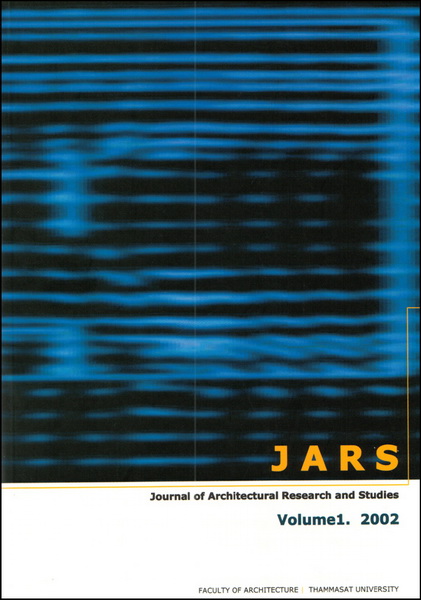Shopping Center/Shopping Mall: Architecture of the Spectacle, Abstract Machine and Urbanism in the 21st Century
Main Article Content
Abstract
Since the development of the “department store” and through Industrial Revolution, consumer culture has been changed to that of consumerism of the western society in the 19th Century. Mass production has tended to accommodate society at large, and the rise of middle-class people has also claimed for identity in social structure. At these crossing points, a new kind of “public space” has been formed and privately owned by private sector. The shopping center/shopping mall has transformed shopping activity into experience in any environmental setting. The new mechanism of the society could fuse trade with desire under the logic of consumerism. The formation of such places does not only appear in the building form, but also reconstitutes itself as a new kind of public space that fully integrates many services for urban activities. It becomes an architecture that determines behavior and shapes the attitude of the people towards consumerism. By using “image culture” which has been embedded in everyday urbanism and combining with the logic of post-modern architecture, shopping center/shopping mall becomes “signifier” of environment, which can attract every consumer. As a social mechanism, it has become an important urban instrument for every city in the 21st century.
Downloads
Article Details

This work is licensed under a Creative Commons Attribution-NonCommercial-NoDerivatives 4.0 International License.
All material is licensed under the terms of the Creative Commons Attribution 4.0 International (CC-BY-NC-ND 4.0) License, unless otherwise stated. As such, authors are free to share, copy, and redistribute the material in any medium or format. The authors must give appropriate credit, provide a link to the license, and indicate if changes were made. The authors may do so in any reasonable manner, but not in any way that suggests the licensor endorses you or your use. The authors may not use the material for commercial purposes. If the authors remix, transform, or build upon the material, they may not distribute the modified material, unless permission is obtained from JARS. Final, accepted versions of the paper may be posted on third party repositories, provided appropriate acknowledgement to the original source is clearly noted.
References
ไชยรัตน์ เจริญสินโอฬาร. (2542). วาทกรรมการพัฒนาพิมพ์ครั้งที่2. กรุงเทพฯ: สํานักพิมพ์วิภาษา, 221. งานเขียนเชิงวิพากษ์เกี่ยวกับศูนย์การค้าสามารถศึกษาได้จากเล่มเดียวกันหน้า 221-231.
แนวคิดเกี่ยวกับ“จักรกลเชิงธรรม(Abstract Machine)” สามารถศึกษาเพิ่มเติมได้จากงานเขียนของ Deleuze, G., Guattari, F. (1987). A thousand plateaus: Capitalism & schizophrenia. Minneapolis: University of Minnesota Press.
วิมลสิทธิ์ หรยางกูร, กอบกุล อินทรวิจิตร, สันติ ฉันทวิลาสวงศ์, และวีระ อินพันทัง. (2536). พัฒนาการแนวความคิดและรูปแบบของงานสถาปัตยกรรม: อดีตปัจจุบันและอนาคต.สนับสนุนโดยสมาคมสถาปนิกสยามในพระบรมราชูปถัมภ์. กรุงเทพฯ: อมรินทร์พริ้นติ้งกรุ๊ป, 380.
Nuttgens, P. (1983). The story of architecture. London: Phaidon Press, 250-251.
Ibid., 254-255.
Longstreth, R. (1997). City center to regional mall: Architecture, the automobile, and retailing in Los Angeles,1920-1950. Cambridge: MIT Press, 323-331.
Koolhaas, R., Boeri, S., Kwinter, S., Tazi, N., & Obrist, H. (2000). Mutations. Barcelona: ACTAR, 132-134. งานวิจัยเกี่ยวกับ shopping ในหนังสือเล่มนี้สามารถศึกษาเพิ่มเติมได้จาก Chung, C. J., Inaba, J., Koolhaas, R., & Leong, S. T. (2001). The Harvard design school guide to shopping. Köln:Taschen.
Ibid., 132-134. (ดัดแปลงจากบทความ)
Longstreth, R. (1997), 325.
Bergren, A. (1998). Jon Jerde and the architecture of pleasure. Assemblage No.37. Cambridge: MIT Press, 8-35.
Koolhaas, R. (1994). Delirious New York. New York: The Monacelli Press.
วิมลสิทธิ์ หรยางกูร. (2530). “สถาปัตยกรรมโพสต์โมเดิร์นจากสถาปัตยกรรม“ซื่อบื้อ” ถึงสถาปัตยกรรม“อะไรก็ได้”: การ-วิเคราะห์ที่มาที่ไปและมูลฐานเชิงพฤติกรรม. อาษาฉบับที่5, 63.
Foucault, F. (1979). Discipline and punish: The birth of the prison. New York: Vintage Books.
Deleuze, G. (1988). Foucault. Minneapolis: University of Minnesota Press, 34.
Ibid., 34.
Ibid., 35.
Ibid., 37.
Lynn, G. (1995). Forms of expression: The proto-functional potential of diagrams in architectural design. El Croquis. No. 72/73, 29.
Allen, S. (1998). Diagrams matter. Unpublished manuscript.
Harvey, H. (1990). The condition of postmodernity: An enquiry into the origins of cultural change. Oxford: Basil Blackwell, 88.
Debord, G. (1994). The society of the spectacle. New York: Zone Books, 12.
Situationist International (SI) ก่อตั้งเมื่อปี ค.ศ. 1957โดยกลุ่มศิลปินและนักเขียนเป็นตัวแทนขององค์กรแนวหน้า(avant- garde) เพื่อเคลื่อนไหวและสะท้อนความเป็นไปของสังคมวัฒนธรรมและการเมืองผ่านสื่อทางศิลปะงานเขียนและทฤษฎีเกี่ยวกับวิถีชีวิตเมืองโดยวิพากษ์การเปลี่ยนแปลงที่เกิดขึ้นจากภาวะหลังสงครามที่ทุกชีวิตถูกจัดให้อยู่ในรูปแบบเฉพาะทำให้ปัจเจกต้องสูญเสียความเป็นตัวเองและโอกาสในการสร้างสรรค์
Leach, N. (1999). The anaestics of architecture. Cambridge: MIT Press, 56.
งานเขียนเกี่ยวกับSimulations สามารถศึกษาเพิ่มเติมได้จากBaudrillard, J. (1983). Simulations. New York: Semiotext. และงานเขียนของไชยรัตนเจริญสินโอฬาร. (2542). วาทกรรมการพัฒนาพิมพ์ครั้งที่2. กรุงเทพฯ: สํานักพิมพ์วิภาษา, 240-247.
ไชยรัตน์ เจริญสินโอฬาร. (2542), 240. [26] Venturi, R., Scott-Brown, D., & Izenour, S. (1972). Learning from Las Vegas. Cambridge: MIT Press,1988.


